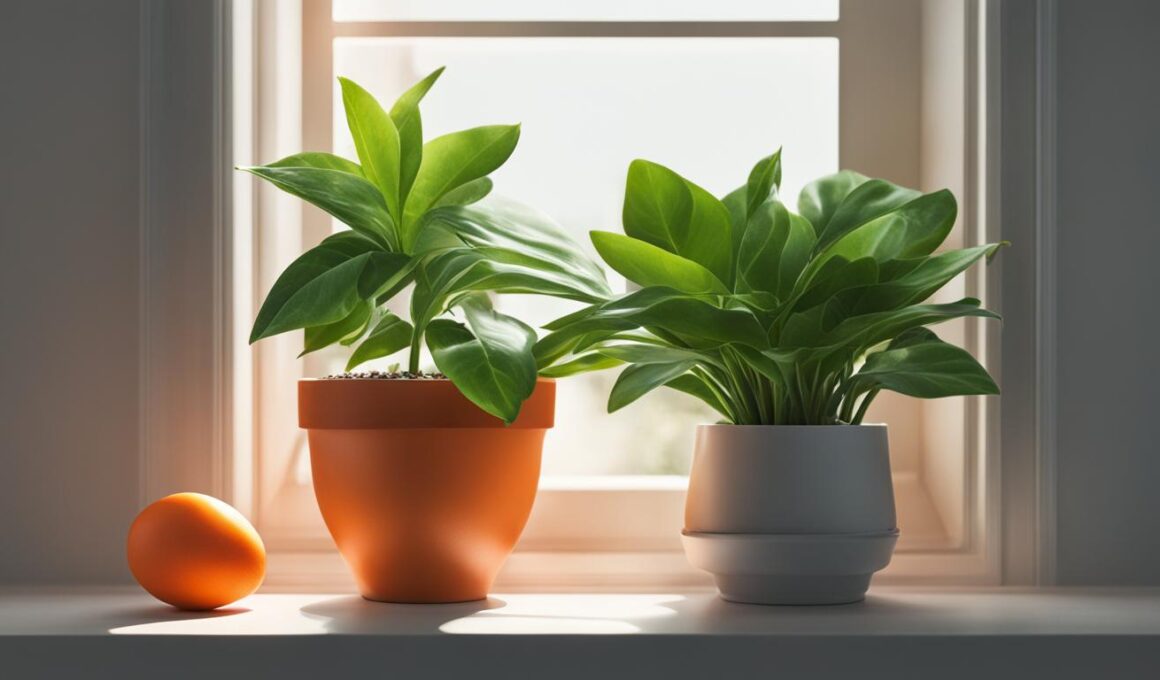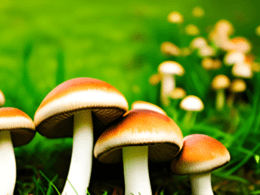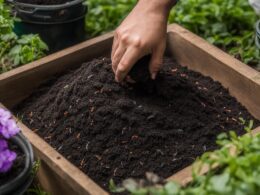Proper plant care is essential for raising thriving houseplants. One vital aspect of plant nutrition is providing them with enough calcium. Just like humans and animals, houseplants need calcium for their growth and health. Calcium strengthens cell walls, aids in nutrient absorption, and enhances the plant’s resistance to pests and diseases.
Without sufficient calcium, plants can suffer from issues such as yellowing leaves, wilting, and stunted growth. To ensure your houseplants get the calcium they need, there are various methods available. You can use water-soluble fertilizer, limestone, bone meal, eggshells, or calcium supplements.
Post Summary:- Proper plant care involves providing houseplants with essential nutrients, including calcium.
- Calcium strengthens cell walls and helps plants absorb nutrients, making them more resistant to pests and diseases.
- Signs of calcium deficiency in plants include yellowing leaves, wilting, and stunted growth.
- Water-soluble fertilizer, limestone, bone meal, eggshells, and calcium supplements are effective ways to provide calcium to your houseplants.
- Some houseplants that benefit from a calcium supplement include African Violets, Begonias, Bromeliads, Cacti, Caladiums, Cast Iron Plants, Chrysanthemums, Coleus, and Croton.
What Do Plants Need to Grow Strong and Healthy?
In addition to nitrogen, phosphorus, and potassium, plants also need calcium to grow strong and healthy. Calcium plays a crucial role in several aspects of plant growth and development. It is a vital component of cell walls, providing structural support and helping plants withstand external pressures. Calcium also plays a key role in nutrient uptake, facilitating the absorption of other essential nutrients from the soil. Furthermore, calcium strengthens plants, making them less susceptible to pests and diseases.
Without sufficient calcium, plants may experience various issues. Blossom end rot is a common disorder associated with calcium deficiency, characterized by brown, rotten spots on the ends of fruits. Calcium deficiency can also result in tip burn, causing the tips of plant leaves to turn brown and dry out. In addition, leaf necrosis, yellowing leaves, and weak stems that break easily are all signs that a plant is lacking the necessary calcium.
It is essential to ensure that your plants are receiving adequate amounts of calcium to promote their optimal growth and overall health. By providing the necessary plant nutrients, including calcium, you can help your plants develop strong cell walls, improve nutrient uptake, and increase their resistance to pests and diseases.
What Do Plants Need to Grow Strong and Healthy?
How Do You Know if Your Plants Are Getting the Right Nutrients?
Plants, just like humans, have specific nutritional requirements to grow strong and healthy. It is essential to ensure that your plants are getting the right nutrients, including calcium, to promote optimal growth and prevent nutrient deficiencies. By observing the signs and symptoms of nutrient deficiencies in plants, you can identify if your plants are receiving adequate nutrition.
One common sign of nutrient deficiency in plants is yellowing leaves. When plants lack essential nutrients like calcium, their leaves may turn yellow and show signs of chlorosis. Additionally, weak stems that break easily can indicate a lack of nutrients, including calcium. If your plants have small and distorted leaves, it may be a sign of inadequate nutrient uptake, including calcium deficiency.
“Yellowing leaves and weak stems can be signs of nutrient deficiency in plants.”
Other signs of calcium deficiency in plants include blossom end rot, tip burn, and leaf necrosis. Blossom end rot is a condition where the bottom of fruits, such as tomatoes or peppers, becomes soft and dark. Tip burn is the browning and drying of leaf edges, while leaf necrosis refers to the death of leaf tissue. These symptoms can be indicative of calcium deficiency in plants.
To accurately diagnose nutrient deficiencies and determine if your plants lack calcium, it is recommended to consult with a local nursery or Extension office. They can provide expert advice and recommend appropriate corrective measures. Conducting regular soil tests can also help identify if your plants need additional calcium or other nutrients to flourish.
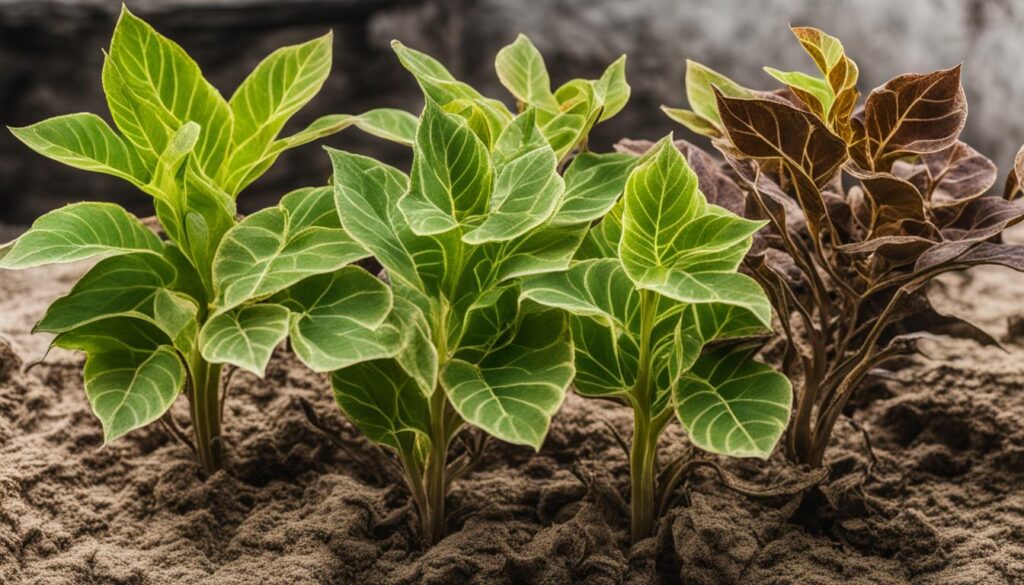
Common Signs of Nutrient Deficiency in Plants:
- Yellowing leaves
- Weak stems
- Small and distorted leaves
- Blossom end rot
- Tip burn
- Leaf necrosis
By monitoring and addressing nutrient deficiencies in your plants, you can ensure they receive the proper nourishment they need to thrive and grow vigorously.
How Can You Add Calcium to Your Plants’ Diet to Help Them Grow Better and Stronger?
| Calcium Source | Method of Application |
|---|---|
| Water-soluble fertilizer | Dilute according to package instructions and water plants regularly |
| Limestone | Add to soil to raise pH and provide slow-release calcium |
| Bone meal | Mix into soil during planting or sprinkle around the base of plants |
| Eggshells | Crush and sprinkle around the base of plants or mix into soil |
| Calcium supplement | Add to water and use for watering plants as directed |
Adding calcium to your plants’ diet is essential for their growth and strength. There are several methods you can use to ensure they receive enough calcium. One option is to use water-soluble fertilizer that contains calcium. Dilute the fertilizer according to the package instructions and water your plants regularly to provide a steady supply of calcium.
Another way to add calcium is by using limestone. This mineral can be added to the soil to raise its pH level and provide a slow-release source of calcium for your plants. Simply incorporate the limestone into the soil around your plants.
Bone meal and eggshells are natural sources of calcium that can be used in your garden. Mix bone meal into the soil during planting or sprinkle it around the base of established plants. Crushed eggshells can also be sprinkled around the base of plants or mixed into the soil to provide a calcium boost.
Lastly, you can use a calcium supplement specifically designed for plants. These supplements can be added to water and used for watering your plants as directed. Follow the instructions on the supplement label and test the pH of your soil before adding any amendments to ensure your plants receive the right amount of calcium.
Take Care of Your Houseplants with Adequate Calcium Nutrition
Adding calcium to your plants’ diet is crucial for their overall health and development. Calcium helps strengthen cell walls, enhances nutrient uptake, and improves the plants’ resilience against pests and diseases. Choose a method that suits your gardening preferences and the specific needs of your houseplants.
Whether you opt for water-soluble fertilizer, limestone, bone meal, eggshells, or a calcium supplement, make sure to follow the recommended instructions. Test the pH of your soil for an accurate understanding of your plants’ calcium requirements. Providing the right amount of calcium will support the vigorous growth and vitality of your houseplants, leading to a thriving indoor garden.
What Houseplants Need Calcium?
Most houseplants require calcium for strong cell walls, nutrient uptake, and overall health. Adding a calcium supplement to their diet can help them grow better and stronger. Some houseplants that benefit from a calcium supplement include:
- African Violets
- Begonias
- Bromeliads
- Cacti
- Caladiums
- Cast Iron Plants
- Chrysanthemums
- Coleus
- Croton
If you are unsure whether your plants need calcium, you can test the pH of the soil. Most houseplants thrive in soil with a pH of around six, and if it is below that, your plants may benefit from a calcium supplement.
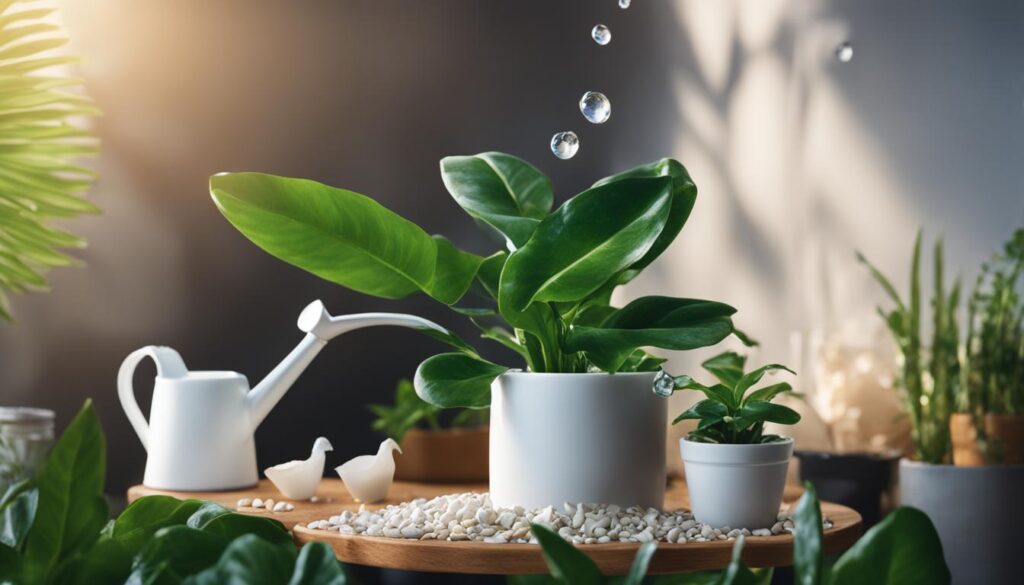
Providing your houseplants with the right nutrients, including calcium, is essential for their growth and overall health. By meeting their calcium needs, you can help strengthen their cell walls, improve nutrient uptake, and make them more resilient to pests and diseases.
How to Make Liquid Calcium for Plants
Adding calcium to your plants’ diet is essential for their growth and overall health. While there are various ways to provide calcium to your houseplants, making a liquid calcium supplement is a simple and effective method. By creating a liquid form, you can ensure that the calcium is easily absorbed by the plants’ roots, where it is needed most.
To make liquid calcium for your plants, you have two options: powdered calcium or eggshells. If using powdered calcium, mix two to four tablespoons per gallon of water. Stir the mixture until the calcium is completely dissolved. Alternatively, you can pulverize eggshells and use them as a natural source of calcium. Combine two to four tablespoons of pulverized eggshells with water, stirring until well-mixed.
It is important to note that the liquid calcium should be used within 24 hours of preparation, as it will start to degrade over time. To ensure your houseplants receive the optimal amount of calcium, water them with the liquid calcium supplement. This method allows the calcium to reach the roots directly, promoting stronger cell walls and improved nutrient uptake.
By incorporating liquid calcium into your plant care routine, you can provide your houseplants with the essential nutrient they need for optimal growth and health. Experiment with different methods and ratios to find what works best for your specific plants. Remember to test the pH of your soil before adding any amendments and adjust accordingly to create an ideal environment for your houseplants.
What Are the Benefits and Proper Method of Feeding Houseplants with Tomorite?
Feeding houseplants with tomorite benefits them in various ways. This specialized fertilizer contains essential nutrients like nitrogen, potassium, and phosphorus, promoting robust growth and vibrant blooms. The proper method involves diluting the concentrated solution according to package instructions and incorporating it into the watering routine. Remember, regular application ensures optimal nourishment for healthy and thriving houseplants.
Conclusion
Taking care of your houseplants’ calcium nutrition is essential for ensuring strong and healthy plants. Calcium plays a crucial role in strengthening cell walls, enhancing nutrient uptake, and increasing resistance to pests and diseases. By providing your houseplants with the right amount of calcium, you can promote their robust growth and overall well-being.
There are various ways to incorporate calcium into your plants’ diet. You can choose to use water-soluble fertilizer, limestone, bone meal, eggshells, or calcium supplements. These options provide convenient and effective ways to ensure your plants receive the necessary calcium for optimal health. Remember to follow the instructions on the package or supplement label and test the pH of your soil before making any amendments.
It is important to remember that not all houseplants require a calcium supplement. African Violets, Begonias, Bromeliads, Cacti, Caladiums, Cast Iron Plants, Chrysanthemums, Coleus, and Croton are among the houseplants that benefit from additional calcium. Testing the soil pH can help determine if your plants need a calcium supplement, as a soil pH of around six is ideal for most houseplants.
By prioritizing houseplant care and providing them with the necessary nutrients, including calcium, you can raise strong and healthy plants that will thrive in your home. Remember to monitor your plants for signs of nutrient deficiency and consult with local nurseries or Extension offices for accurate diagnosis and treatment recommendations. With proper care and attention, your houseplants will flourish and bring beauty into your living space.
FAQ
How does calcium benefit houseplants?
Calcium strengthens cell walls, aids in nutrient absorption, and helps plants resist pests and diseases.
What are the signs of calcium deficiency in plants?
Signs of calcium deficiency include yellowing leaves, wilting, and stunted growth.
What are the common nutrient deficiencies in plants?
Common nutrient deficiencies include nitrogen, phosphorus, potassium, and calcium.
How can I ensure my houseplants get enough calcium?
You can use water-soluble fertilizer, limestone, bone meal, eggshells, or calcium supplements.
Which houseplants benefit from a calcium supplement?
African Violets, Begonias, Bromeliads, Cacti, Caladiums, Cast Iron Plants, Chrysanthemums, Coleus, and Croton are some examples.
How can I make liquid calcium for plants?
Mix powdered calcium or pulverized eggshells with water in a ratio of two to four tablespoons per gallon of water.
Why is calcium important for houseplants?
Calcium strengthens cell walls, aids nutrient uptake, and promotes overall plant health.





